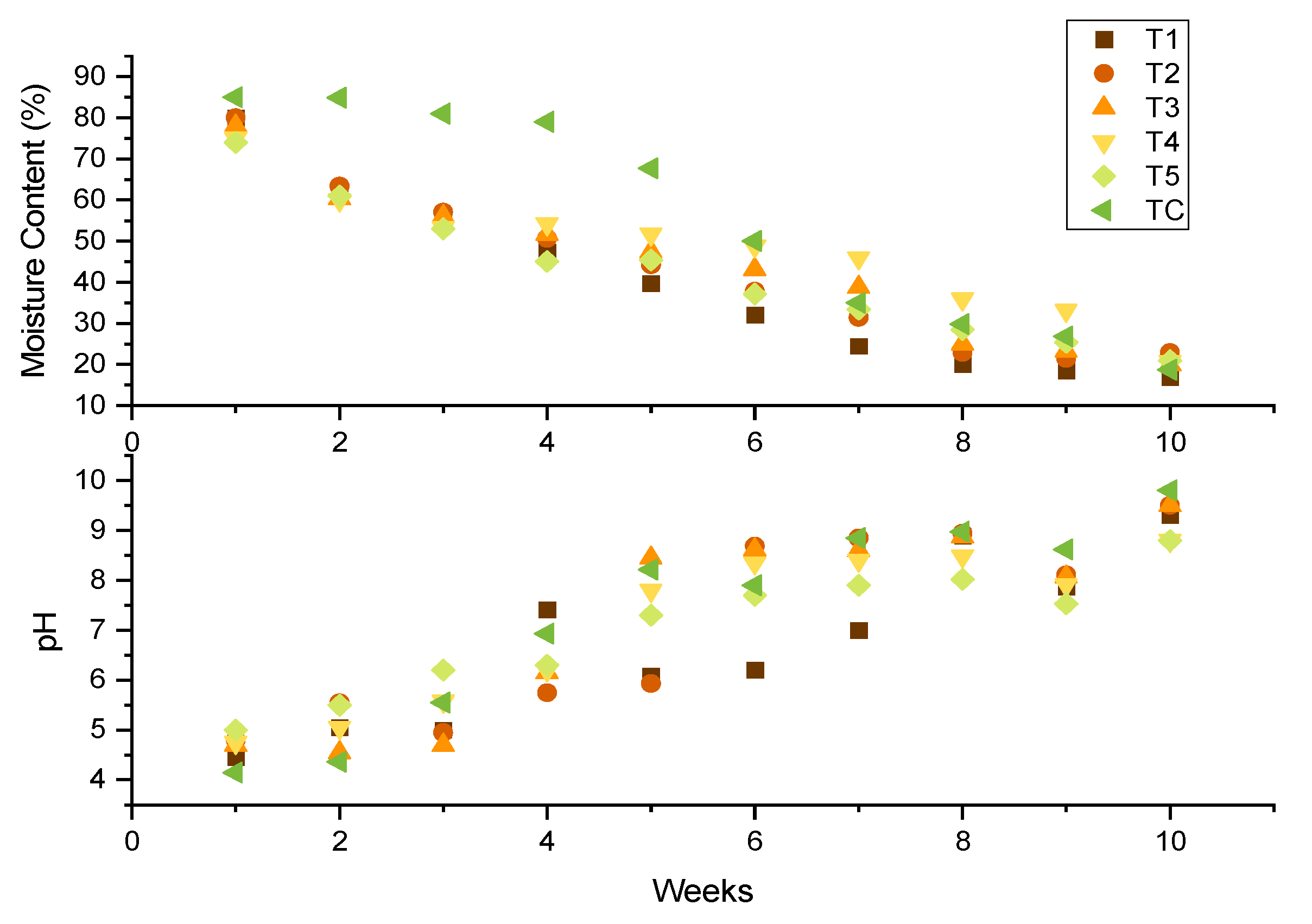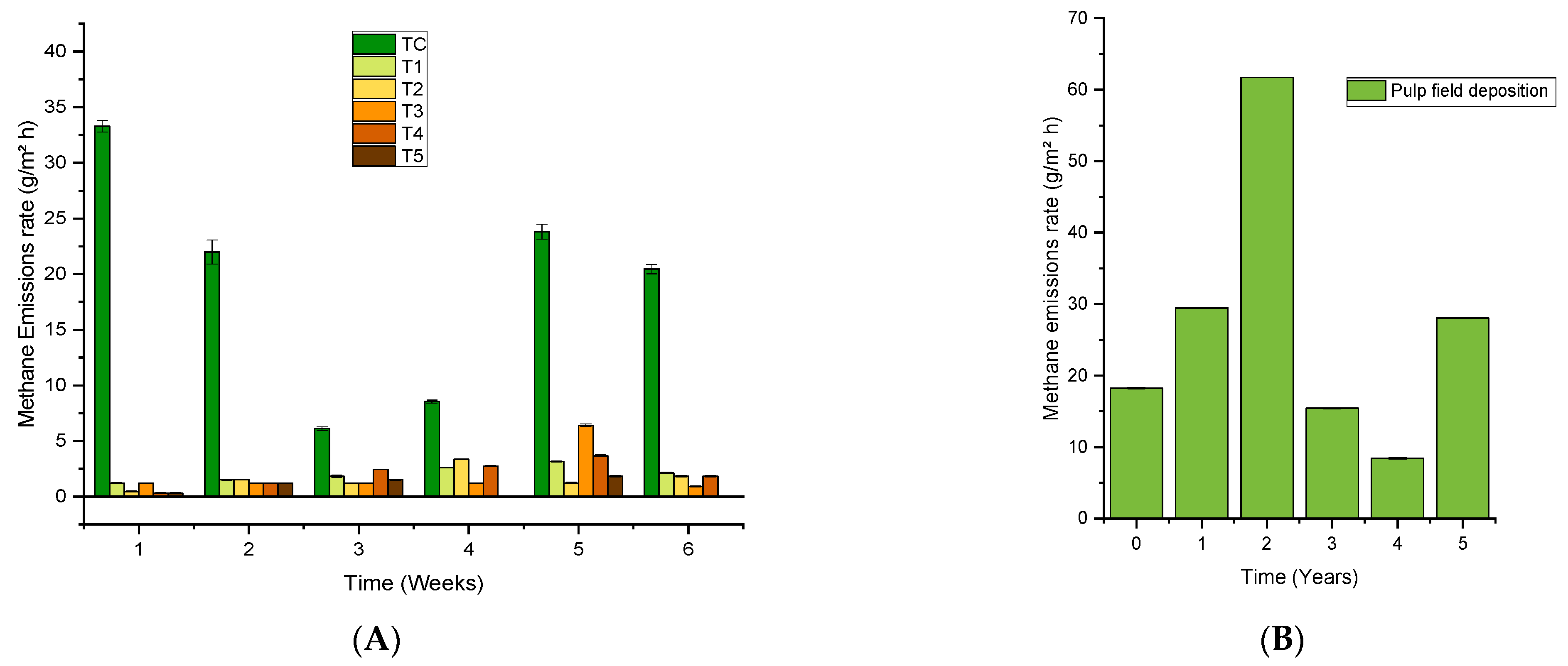In the last 20 years, the demand fCor coffee production has increased detrimentally, heightening the need for production, which is currently driving the increase in land cultivation for coffee. However, this increase in ffee is a worldwide used production ultimately leads to the amplification of waste produced. This study aims to develop an experimental methodology for sustainable coffee by-products (Pulp (CP)) in Costa Rica for nutrient-rich compost. The performance of the experiments is to explore and optimize composting processes following its key parameters. This will allow quantifying the emissions rate to obtain an emission factor for CP during the open composting process and optimizing the conditions to minimize CH4 emissions using P and green waste (GW) materials and of the most valued commodities in trade, being one of the most important agricultural exports in Costa Rica.
- coffee pulp
- coffee by-products
- composting
- methane
- emissions rate
- emissions factor
1. Introduction
2. Methane Gas Emissions


| Treatment | EF (g CH | 4 | /kg CP) | EF (g CH | 4 | /kg Input) | SD * |
|---|---|---|---|---|---|---|---|
| T1 | 43.9 | 35.1 | 0.23 | ||||
| T2 | 14.4 | 10.8 | 0.17 | ||||
| T3 | 20 | 14 | 0.23 | ||||
| T4 | 23.4 | 14 | 0.24 | ||||
| T5 | 11.6 | 5.8 | 0.14 | ||||
| TC | 129 | 129 | 2.96 |
3. Conclusions
References
- Smith, P.; Bustamante, M.; Ahammad, H.; Clark, H.; Dong, H.; Elsiddig, E.A.; Haberl, H.; Harper, R.; House, J.; Jafari, M.; et al. Agriculture, Forestry and Other Land Use (AFOLU). In Climate Change 2014 Mitigation of Climate Change Mitigation of Climate Change. Contribution of Working Group III to the Fifth Assessment Report of the Intergovern-Mental Panel on Climate Change; Edenhofer, O., Pichs-Madruga, R., Sokona, Y., Farahani, E., Kadner, S., Seyboth, K., Adler, A., Baum, I., Brunner, S., Eickemeier, P., Eds.; Cambridge University Press: Cambridge, UK, 2014; pp. 811–922.
- Bridgham, S.D.; Richardson, C.J. Mechanisms controlling soil respiration (CO2 and CH4) in southern peatlands. Soil Biol. Biochem. 1992, 24, 1089–1099.
- Vergara, S.E.; Silver, W.L. Greenhouse gas emissions from windrow composting of organic wastes: Patterns and emissions factors. Environ. Res. Lett. 2019, 14, 124027.
- US EPA. AP 42, Fifth Edition Compilation of Air Pollutant Emission Factors, Volume 1: Stationary and Point Sources; US EPA: Research Triangle Park, NC, USA, 1995; pp. 1–10.
- Amlinger, F.; Peyr, S.; Cuhls, C. Green house gas emissions from composting and mechanical biological treatment. Waste Manag. Res. 2008, 26, 47–60.
- Sánchez, A.; Gabarrell, X.; Artola, A.; Barrena, R.; Colón, J.; Font, X.; Komilis, D.; Taherzadeh, M.J.; Richards, T. Composting of Wastes. Resource Recovery to Approach Zero Municipal Waste, 1st. ed.; Taherzadeh, M.J., Richards, T., Eds.; Green Chemistry and Chemical Engineering: Boca Raton, FL, USA, 2015; pp. 77–106.
- Blinová, L.; Sirotiak, M.; Bartošová, A.; Soldán, M. Review: Utilization of Waste from Coffee Production. Res. Pap. Fac. Mater. Sci. Technol. Slovak Univ. Technol. 2017, 25, 91–101.
- Chong, J.A.; Dumas, J.A. Coffee pulp compost: Chemical properties and distribution of humic substances. J. Agric. Univ. Puerto Rico 2012, 96, 77–87.
- Braham, J.; Bressani, R. Coffee Pulp: Composition, Technology, and Utilization; IDRC: Ottawa, ON, Canada, 1979.
- San Martin Ruiz, M.; Reiser, M.; Hafner, G.; Kranert, M. A Study about Methane Emissions from Different Composting Systems for Coffee By-products on Costa Rica. Environ. Ecol. Res. 2018, 6, 461–470.
- Chala, B.; Oechsner, H.; Latif, S.; Müller, J. Biogas Potential of Coffee Processing Waste in Ethiopia. Sustainability 2018, 10, 2678.
- Beyene, A.; Kassahun, Y.; Addis, T.; Assefa, F.; Amsalu, A.; Legesse, W.; Kloos, H.; Triest, L. The impact of traditional coffee processing on river water quality in Ethiopia and the urgency of adopting sound environmental practices. Environ. Monit. Assess. 2011, 184, 7053–7063.
- Desai, N.M.; Varun, E.; Patil, S.; Pimpley, V.; Murthy, P.S. Environment Pollutants During Coffee Processing and Its Valorization BT. In Handbook of Environmental Materials Management; Hussain, C.M., Ed.; Springer International Publishing: Cham, Switzerland, 2020; pp. 1–13.
- Misra, R.V.; Roy, R.N.; Hiraoka, H.; Food and Agriculture Organisation of the United Nations. FAO On-farm com-posting methods, Composting Methods and Techniques, Rome. 2003. Available online: http://www.fao.org/docrep/007/y5104e/y5104e05.htm (accessed on 17 February 2021).
- Sánchez, A.; Artola, A.; Font, X.; Gea, T.; Barrena, R.; Gabriel, D.; Sánchez-Monedero, M.Á.; Roig, A.; Cayuela, M.L.; Mondini, C. Greenhouse Gas from Organic Waste Composting: Emissions and Measurement. In CO2 Sequestration, Biofuels and Depollution. Environmental Chemistry for a Sustainable World; Lichtfouse, E., Schwarzbauer, J., Robert, D., Eds.; Springer: Cham, Switzerland, 2015; Volume 5.
- Diaz, L.F.; De Bertoldi, M.; Bidlingmaier, W. Compost Science and Technology; Elsevier: Amsterdam, The Netherlands, 2007.
- Haug, R.T. The Practical Handbook of Compost Engineering, 1st ed.; Lewis Publishers: Atascadero, CA, USA, 1993.
- Shemekite, F.; Gómez-Brandón, M.; Franke-Whittle, I.H.; Praehauser, B.; Insam, H.; Assefa, F. Coffee husk composting: An investigation of the process using molecular and non-molecular tools. Waste Manag. 2014, 34, 642–652.
- VDI Guideline: Emission Control Mechnical-Biological Treatment Facilities for Municipal Solid Waste; VDI 3475 Part 3; Beuth Verlag GmbH: Berlin, Germany, 2006.
- Kranert, M. Einführung in die Kreislaufwirtschaft: Planung-Recht-Verfahren; Springer: Vieweg, Wiesbaden, 2017.
- Shilev, S.; Naydenov, M.; Vancheva, V.; Aladjadjiyan, A. Composting of Food and Agricultural Wastes. In Utilization of By-Products and Treatment of Waste in the Food Industry; Springer: Berlin, Germany, 2006; pp. 283–301.
- Ghazifard, A.; Kasra-Kermanshahi, R.; Far, Z.E. Identification of thermophilic and mesophilic bacteria and fungi in Esfahan (Iran) municipal solid waste compost. Waste Manag. Res. 2001, 19, 257–261.
- Azim, K.; Soudi, B.; Boukhari, S.; Perissol, C.; Roussos, S.; Alami, I.T. Composting parameters and compost quality: A literature review. Org. Agric. 2018, 8, 141–158.
- IVillar, I.; Alves, D.; Garrido, J.; Mato, S. Evolution of microbial dynamics during the maturation phase of the composting of different types of waste. Waste Manag. 2016, 54, 83–92.
- Zhu-Barker, X.; Bailey, S.K.; Paw, U.K.T.; Burger, M.; Horwath, W.R. Greenhouse gas emissions from green waste composting windrow. Waste Manag. 2017, 59, 70–79.
- VDI Guideline: Emission Control Biological Waste Treatment Facilities Composting and Anaerobic Digestion Plant Capacities More Than Approx. 6; VDI 3575 Part 1; Beuth Verlag GmbH: Berlin, Germany, 2003.
- Sánchez, A.; Artola, A.; Font, X.; Gea, T.; Barrena, R.; Gabriel, D.; Sanchez-Monedero, M.A.; Roig, A.; Cayuela, M.L.; Mondini, C. Greenhouse gas emissions from organic waste composting. Environ. Chem. Lett. 2015, 13, 223–238.
- Díaz, M.V.; Prada, P.; Mondragon, M. Optimización del proceso de compostaje de productos post-cosecha (cereza) del café con la aplicación de microorganismos nativos. Nova 2010, 8, 214.
- Muzaifa, M.; Rahmi, F.; Syarifudin. Utilization of Coffee By-Products as Profitable Foods—A Mini Review. IOP Conf. Ser. Earth Environ. Sci. 2021, 672, 012077.
- Ijanu, E.M.; Kamaruddin, M.A.; Norashiddin, F.A. Coffee processing wastewater treatment: A critical review on current treatment technologies with a proposed alternative. Appl. Water Sci. 2019, 10, 11.
- Duong, B.; Marraccini, P.; Maeght, J.-L.; Vaast, P.; Lebrun, M.; Duponnois, R. Coffee Microbiota and Its Potential Use in Sustainable Crop Management. A Review. Front. Sustain. Food Syst. 2020, 4, 237.
- Hao, X.; Benke, M.B. Nitrogen Transformation and Losses during Composting and Mitigation Strategies; Global Science Books: Isleworth, UK, 2008.
- Taconi, K.A.; Zappi, M.E.; French, W.T.; Brown, L.R. Methanogenesis under acidic pH conditions in a semi-continuous reactor system. Bioresour. Technol. 2008, 99, 8075–8081.
- Ermolaev, E.; Sundberg, C.; Pell, M.; Smårs, S.; Jönsson, H. Effects of moisture on emissions of methane, nitrous oxide and carbon dioxide from food and garden waste composting. J. Clean. Prod. 2019, 240, 118165.
- Moldvaer, A. Coffee Obsession, 1st ed.; Dorling Kindersley Limited: London, UK, 2014.
- Jiang, T.; Schuchardt, F.; Li, G.; Guo, R.; Zhao, Y. Effect of C/N ratio, aeration rate and moisture content on ammonia and greenhouse gas emission during the composting. J. Environ. Sci. 2011, 23, 1754–1760.
- Jäckel, U.; Thummes, K.; Kämpfer, P. Thermophilic methane production and oxidation in compost. FEMS Microbiol. Ecol. 2005, 52, 175–184.
- IMN. Factores de Emisión Gases Efecto Invernadero, San José, Costa Rica. 2020. Available online: http://cglobal.imn.ac.cr/index.php/publications/factores-de-emision-gei-decima-edicion-2020/ (accessed on 10 February 2021).
- IPCC. Volume 5 Waste-Chapter 4 Biological Treatment of Solid Waste, 2006 IPPC Guidel. National Greenhouse Gas Inventories. 2006, pp. 4.1–4.8. Available online: http://www.ipcc-nggip.iges.or.jp/public/2006gl/vol5.html (accessed on 5 February 2021).
- ARB. Air Resources Board (ARB): Method for Estimating Greenhouse Gas Emission Reduction from Diversion of Organic Waste from Landfills to Compost Facilities. 2017. Available online: https://ww2.arb.ca.gov/sites/default/files/classic/cc/waste/cerffinal.pdf (accessed on 18 February 2021).
